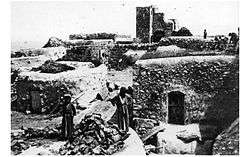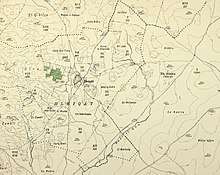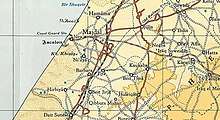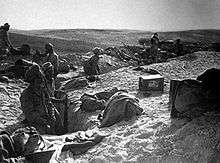Hulayqat
Hulayqat was a Palestinian Arab village in the Gaza Subdistrict. It was depopulated during the 1947–1948 Civil War in Mandatory Palestine. It was located 20.5 km northeast of Gaza.
Hulayqat حليقات | |
|---|---|
 Hulayqat, before 1948 | |
| Etymology: the circles[1] | |
.jpg) .jpg) .jpg) .jpg) A series of historical maps of the area around Hulayqat (click the buttons) | |
 Hulayqat Location within Mandatory Palestine | |
| Coordinates: | |
| Palestine grid | 116/112 |
| Geopolitical entity | Mandatory Palestine |
| Subdistrict | Gaza |
| Date of depopulation | May 12, 1948[2] |
| Population (1945) | |
| • Total | 420[3][4] |
| Cause(s) of depopulation | Influence of nearby town's fall |
History
Hulayqat had numerous khirbas. Artifacts include pieces of marble and pottery as well as cisterns and a pool.[5]
Ottoman era
In 1838, in the Ottoman era, Huleikat was noted as village in the Gaza district.[6]
An Ottoman village list from about 1870 showed that Hulayqat had a population of 55, with a total of 14 houses, though the population count included men, only.[7][8]
In 1883, the PEF's Survey of Western Palestine described it as a "small village on a flat slope, with a high sandy hill to the west. It has cisterns and a pond, with a small garden to the west.”[9]
British Mandate era

In the 1922 census of Palestine, conducted by the British Mandate authorities, Hukiqat had a population of 251 inhabitants, all Muslims,[10] increasing in the 1931 census to 285, still all Muslims, in 61 houses.[11]

In the 1945 statistics Huleiqat had a population of 420 Muslims,[3] with a total of 7,063 dunams of land, according to an official land and population survey.[4] Of this, 115 dunams were used for plantations and irrigable land, 6,636 for cereals,[12] while they had 18 dunams as built-up land.[13]
In 1947, an oil drilling project commenced in Hulayqat employing 300 Arab workers.[14]
1948, aftermath
The village was first captured by the Israeli army on 13 May during Operation Barak and depopulated.[15][16] On 8 July, it was retaken by the Egyptian army. A well-fortified battalion of the 4th Brigade was stationed there later reinforced by more troops.[17] and some of the villagers returned to their homes. It was finally captured on 19 October by the Giv'ati Brigade during Operation Yoav.[5]

According to the Palestinian historian Walid Khalidi, the ruin of the village in 1992 was partially forested with sycamore, Christ's-thorn trees and cactus. One of the old roads had been paved.[5]
See also
References
- Palmer, 1881, p. 367
- Morris, 2004, p. xix, village #317. Also gives cause for depopulation
- Department of Statistics, 1945, p. 31
- Government of Palestine, Department of Statistics. Village Statistics, April, 1945. Quoted in Hadawi, 1970, p. 45
- Khalidi, 1992, p. 104
- Robinson and Smith, 1841, vol 3, Appendix 2, p. 119
- Socin, 1879, p. 149
- Hartmann, 1883, p. 148
- Conder and Kitchener, 1883, SWP III, p. 260
- Barron, 1923, Table V, Sub-district of Gaza, p. 8
- Mills, 1932, p. 3
- Government of Palestine, Department of Statistics. Village Statistics, April, 1945. Quoted in Hadawi, 1970, p. 87
- Government of Palestine, Department of Statistics. Village Statistics, April, 1945. Quoted in Hadawi, 1970, p. 137
- Drilling begins near Gaza
- Tal, 2004, p. 174
- Morris, 2004, p. 258
- Tal, 2004, p. 385
Bibliography
- Barron, J.B., ed. (1923). Palestine: Report and General Abstracts of the Census of 1922. Government of Palestine.
- Conder, C.R.; Kitchener, H.H. (1883). The Survey of Western Palestine: Memoirs of the Topography, Orography, Hydrography, and Archaeology. 3. London: Committee of the Palestine Exploration Fund.
- Department of Statistics (1945). Village Statistics, April, 1945. Government of Palestine.
- Hadawi, S. (1970). Village Statistics of 1945: A Classification of Land and Area ownership in Palestine. Palestine Liberation Organization Research Center.
- Hartmann, M. (1883). "Die Ortschaftenliste des Liwa Jerusalem in dem turkeschen Staatskalender dur Syrien auf das Jahr 1288 der Flucht (1871)". Zeitschrift des Deutschen Palästina-Vereins. 6: 102–149.
- Khalidi, W. (1992). All That Remains: The Palestinian Villages Occupied and Depopulated by Israel in 1948. Washington D.C.: Institute for Palestine Studies. ISBN 0-88728-224-5.
- Mills, E., ed. (1932). Census of Palestine 1931. Population of Villages, Towns and Administrative Areas. Jerusalem: Government of Palestine.
- Morris, B. (2004). The Birth of the Palestinian Refugee Problem Revisited. Cambridge University Press. ISBN 978-0-521-00967-6.
- Palmer, E.H. (1881). The Survey of Western Palestine: Arabic and English Name Lists Collected During the Survey by Lieutenants Conder and Kitchener, R. E. Transliterated and Explained by E.H. Palmer. Committee of the Palestine Exploration Fund.
- Robinson, E.; Smith, E. (1841). Biblical Researches in Palestine, Mount Sinai and Arabia Petraea: A Journal of Travels in the year 1838. 3. Boston: Crocker & Brewster.
- Socin, A. (1879). "Alphabetisches Verzeichniss von Ortschaften des Paschalik Jerusalem". Zeitschrift des Deutschen Palästina-Vereins. 2: 135–163.
- Tal, D. (2004). War in Palestine, 1948: Israeli and Arab Strategy and Diplomacy. Routledge. ISBN 0-7146-5275-X.
External links
- Welcome To Hulayqat
- Hulayqat, Zochrot
- Survey of Western Palestine, Map 20: IAA, Wikimedia commons
- Hulayqat, from the Khalil Sakakini Cultural Center